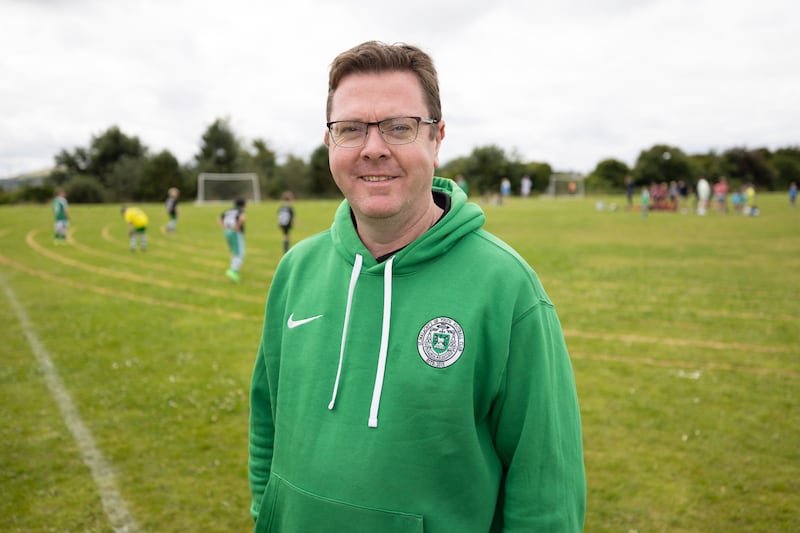At Lisneal College in Derry the pitches are full not of boys playing football, but girls.
“It makes you feel proud to be a girl,” says Ciara Scollay, the mother of two football-mad daughters. “Walking in here for me feels really emotional and really powerful, and I can only imagine what it feels like when you’re a 10-year-old walking in here.
“Girls’ football has come a long way.”
This year it has taken her daughter Eve Maginnis’s team – the under 11 girls from St Malachy’s OB Youth Football Club in North Belfast – all the way to the O’Neill’s Foyle Cup. This annual festival of junior football features 700 teams and 13,000 competitors from as far as the US, Canada and China; that’s 3,000 matches, more than 250,000 spectators and £6 million-£8 million for the local economy in Derry, Donegal and Tyrone.
READ MORE
For the first time, about 100 of those teams are girls, a more than five-fold increase compared with before the enforced break of Covid-19.
“It’s massive,” says the tournament secretary Philip Devlin. “We initially started with the girls playing alongside the boys’ leagues, now we have girls’ leagues from under eight up, and it’s had a serious uptake.
“The Euros did a lot for it, when Northern Ireland and the Republic were in it, and also the Lionesses, they got a lot of TV time, so the girls could see it and were watching it, and it made football more fashionable and more accessible, and the local clubs really stepped up and started developing their girls-only teams.
“It just really took off, it’s gained serious momentum within the space of two seasons, and what we’re finding is our biggest numbers are from under 11 down, so it looks like the future is going to be even brighter in the coming years.”
On this weekday afternoon, that future is on display on the Lisneal pitches. Multiple matches are under way, all involving girls’ teams; plaits and ponytails whizz past as young players chase after the ball or celebrate scoring a goal.
Eleven-year-old Rosa Crossan is in no doubt about what football means to her. “I love it, one billion per cent.”
Her friends and St Malachy’s team-mates are preparing for the first of two matches of the afternoon. They proudly display their personalised friendship bracelets – in the team colours of green and black – and even the green braces on one player’s teeth.
“I got them done specially,” says Jasmine Toal (11), while Eve Maginnis demonstrates her ponytail with a white scrunchie like her hero, the Republic of Ireland’s Leanne Kiernan; the entire team was thrilled at Ireland’s 3-1 win over France on Tuesday.
All the St Malachy’s girls – 70 children in total – were in Windsor Park to watch Northern Ireland’s women take on the Republic in December. “That will nurture them, light the fire in them,” says Rosa’s father, head coach and sports journalist Brendan Crossan. “You remember as a kid going to those big matches.”
This is just one of the reasons the redevelopment of Casement Park in west Belfast is a “no-brainer”, says Crossan. “It’s a no-brainer to have the Euros here. It’s the opportunity of a lifetime, but Belfast doesn’t have a vision. We think small all the time.
“It’s about those kids – could you imagine the excitement that would generate in kids?

“That was a big deal for all our kids, to go to that match in Windsor Park, and the thing I loved about it was there were kids in our group that were supporting Marissa Callaghan, who’s playing for Northern Ireland, and there were kids supporting Katie McCabe, who’s Republic of Ireland, and back in our day that wouldn’t have been the case.
“So, I think there’s a wee lesson learned there for our generation.”
There are other lessons too. Rosa has been playing football since she was five years old; at the suggestion that girls are less likely to play football than boys, she is puzzled. “That’s unfair.”
“I don’t care what people think,” chips in Toal. “Playing football is cool. One of my favourite things is, whenever I’m playing against wee boys, I always like to do slide tackles.”
Parents and coaches have noticed the difference football has made. “We only really started last year,” says Tanya Harkin, coach of Ballymoor FC from Derry City. “See the wee community that they’ve formed, they have each other’s backs. You can see the confidence in them, and the sass,” she laughs.
“I’ve seen her taking on leadership, and organising things,” says Siobhán McNulty of her 10-year-old daughter Lara Brady.
“The first time she was made captain, the coach said, ‘you’re doing the team talk’, and I could see her face. But see afterwards, she was buzzing. You could really see her confidence building.”
“I think maybe we’re breaking out of old traditions of what girls and boys do,” says Crossan. “I’m not coaching girls or boys, I’m coaching footballers.
“You wouldn’t believe how many mothers have said to me in the build-up to this, I wish we had a Foyle Cup when we were kids.”
- Sign up for push alerts and have the best news, analysis and comment delivered directly to your phone
- Join The Irish Times on WhatsApp and stay up to date
- Listen to our Inside Politics podcast for the best political chat and analysis












